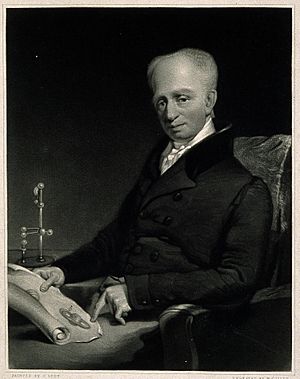Henry Lawson (astronomer) facts for kids
Quick facts for kids
Henry Lawson
|
|
|---|---|
 |
|
| Born | 1774 |
| Died | 1855 |
| Scientific career | |
| Fields | astronomy |
Henry Lawson (1774–1855) was an English astronomer, which means he studied space and the objects in it. He was also an inventor, a designer, and a teacher who loved to share science with young people. He was a kind person who gave money to help others.
Lawson was a member of important science groups like the Royal Astronomical Society and the Royal Society. He observed many interesting things in space, including a time when the planet Saturn passed behind another object in 1832. He also saw Johann Gottfried Galle's first comet and recorded "falling stars" (which are actually meteors) in 1841.
Contents
A Life of Science and Discovery
Henry Lawson was born in Greenwich, England, on March 23, 1774. His father was Johnson Lawson, and his mother was Elizabeth. As a young boy, he went to school with Charles Burney.
Later, Henry became an apprentice at an optical company. This company made things like telescopes and other scientific tools. His stepfather, Edward Nairne, owned the company. Instead of staying in business, Henry decided to focus on studying science. He became very skilled in making and using scientific instruments.
Setting Up an Observatory
After he got married in 1823, Lawson moved to Hereford. He was very interested in astronomy, so in 1826, he built his own observatory. An observatory is a special building where astronomers can look at the sky. He put a five-foot-long telescope there. Later, in 1834, he added an even bigger one, an eleven-foot telescope made by a famous instrument maker named George Dollond.
In 1841, Henry Lawson moved to Bath, Somerset, after inheriting a lot of money. He set up his telescopes on the roof of his house. This allowed him to continue his important observations of the stars and planets.
Sharing Knowledge and Helping Others
Henry Lawson spent a lot of his time encouraging young people to learn about science. He also gave money to many charities. He passed away in Bath on August 22, 1855, when he was 81 years old. He was buried in Weston.
Lawson's Lasting Impact
Henry Lawson was the last person in his family line. He left his large fortune to many different people and several charities. He also gave money to the Royal Astronomical Society, the Royal Society, and the British Meteorological Society, which were the science groups he belonged to.
His Telescopes and Legacy
Lawson wanted his amazing astronomical equipment to keep being used for science. In 1851, he offered his telescopes and money to the town of Nottingham so they could build an observatory. However, the plan didn't work out because of disagreements about the value of his instruments.
Even so, his telescopes found new homes. His large eleven-foot telescope was given to the Royal Hospital School in Greenwich. His five-foot telescope went to another astronomer, William Garrow Lettsom. His weather-measuring tools were given to Edward Joseph Lowe, another scientist.
Lawson's Scientific Work
Henry Lawson made several important observations and inventions during his life.
Observations of the Cosmos
- On May 8, 1832, he observed an occultation of Saturn. This is when one celestial body passes in front of another, blocking its view.
- In December 1839 and January 1840, he observed Johann Gottfried Galle's first comet. Comets are icy objects that orbit the Sun.
- On November 12–13, 1841, he recorded the "falling stars," which are actually meteors burning up in Earth's atmosphere.
Inventions and Publications
Lawson also wrote books and invented useful tools.
- In 1844, he published a paper called On the Arrangement of an Observatory for Practical Astronomy and Meteorology. This book helped others set up their own observatories.
- In 1847, he wrote a short book called History of the New Planets.
The Society of Arts, a group he was part of, gave him a silver medal for inventing a special observing-chair called "Reclinea." This chair helped astronomers sit comfortably while looking through telescopes. He also won a prize for a new type of thermometer stand. He designed a "lifting apparatus" for people who were sick and a "surgical transferrer" for doctors.
Family Life
Henry Lawson lived with his mother until she passed away in 1823. That same year, he married Amelia Jennings. Amelia was the daughter of Thomas Jennings, a vicar from Hereford.

